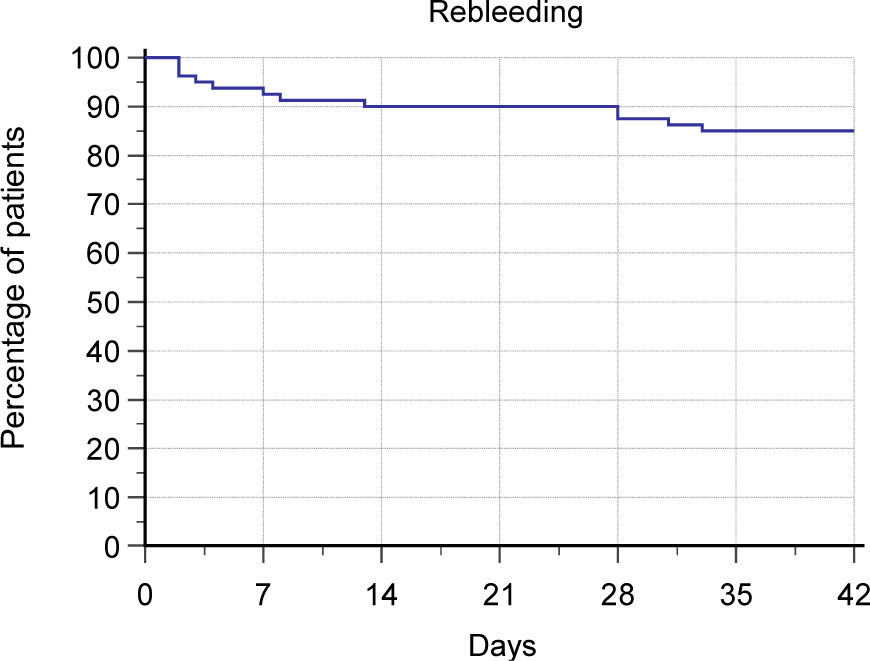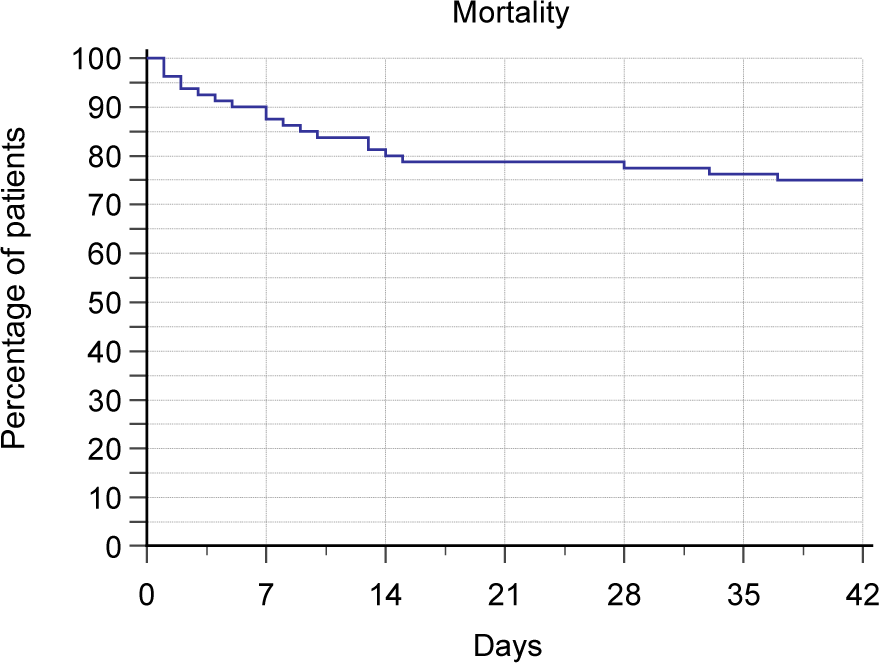1. INTRODUCTION
Variceal bleeding is a major cause of death in cirrhotic patients. Hemostasis can be achieved by endoscopic therapy in up to 80% to 90% of patients with active bleeding [1]. However, approximately one-third of patients with variceal bleeding experienced rebleeding within 6 weeks. Rebleeding risk is greatest during the first 5 days and returns to baseline after the sixth week. The 6-week mortality rate after variceal bleeding is 25% to 30% [2].
6-week mortality was proposed to be the primary treatment endpoint for variceal bleeding by the Baveno VI consensus [3]. Recent American Association for the Study of Liver Diseases (AASLD) guidelines pointed out that risk stratification in variceal bleeding is essential [4]. Several prognostic models were developed to predict mortality and rebleeding risk including CTP score, MELD score, and hepatic venous pressure gradient (HVPG) [5-7]. Ideally, high-risk patients identified by these models receive more aggressive treatment. However, these tools have limited use in clinical practice for some reasons: HVPG measurements are not widely available [5], some components of CTP score have subjectivity [8], and MELD score can be difficult to calculate [8]. In 2011, Saltzman et al. developed a new score called AIMS65 to identify patients with a high risk of in-hospital mortality after upper gastrointestinal bleeding.
AIMS65 score is composed of: Albumin level < 3 g/dL (A), INR > 1.5 (I), Altered Mental Status (M), Systolic Blood Pressure ≤ 90 mmHg (S), and age > 65 years (65). A patient gained 1 point for each risk factor [9]. Serum albumin < 3.0 g/dL and INR > 1.5 are generally considered poor prognostic factors of cirrhosis. Hence, AIMS65 score could be a useful model for risk stratification in variceal bleeding. However, there is not enough data in the literature about the credibility of this scoring system.
This study aimed to evaluate the ability of AIMS65 score in predicting 6-week mortality and rebleeding in cirrhotic patients with variceal bleeding and to compare it with CTP and MELD scores.
2. MATERIALS AND METHOD
Data were collected prospectively at Gastroenterology and Hepatology Department of Cho Ray hospital, Ho Chi Minh City, Vietnam, from September 2016 to April 2017. Cho Ray hospital is a central-level hospital. It is the largest hospital in the South of Vietnam. All patients with cirrhosis and variceal bleeding were enrolled in the study. Cirrhosis was diagnosed based on past medical history, clinical assessment, laboratory tests, and imaging findings suggestive of liver cirrhosis. The source of bleeding was confirmed by endoscopy. Patients with stage D hepatocellular carcinoma (HCC), patients with variceal bleeding 6 weeks before admission, patients with incomplete records, and patients who lost contact before day 42 were excluded from this study. Patients with stage D HCC were excluded because of their high mortality rate (>60%) [5]. Informed consent was obtained from all subjects. The study protocol was approved by the Board of Ethics in Biomedical Research of University and Pharmacy at Ho Chi Minh city (ID number: 216/DHYD-HD signed on July 19th, 2016).
Patients with variceal bleeding were treated with a combination of vasoactive drugs (octreotide or terlipressin), endoscopic band ligation (EVL), and antibiotic prophylaxis with ceftriaxone. Rescue therapy with Sengstaken– Blakemore balloon tamponade was applied in refractory bleeding. Secondary prophylaxis with propranolol was started and titered to maximum tolerated dose if possible after the bleeding had been controlled. Time zero was the time of admission.
The primary endpoint of this study was 6-week mortality and rebleeding. Data regarding demographic, clinical, and laboratory information were collected from clinical records. AIMS65, CTP, and MELD scores were calculated from data obtained at initial presentation. Rebleeding was defined as new hematemesis or melena that occurred 24 hours after hemodynamic stability [10]. During hospitalization, clinical assessment was carried out every day for detecting symptoms of rebleeding. After discharge, telephone follow-up every 2 weeks was provided to collect information about rebleeding and mortality rate.
Calculation of the MELD score [11]: MELD = 3.78 x loge (bilirubin [mg/dL]) + 11.2 x loge (INR) + 9.57 x loge (creatinine [mg/dL]) + 6.43
Calculation of the CTP score [12]:
The data analysis was performed by using SPSS 18 (SPSS Inc, Chicago). Continuous data were shown as mean ± standard deviation (SD). Categorical data were shown as frequencies. ROC curves with 95% confidence intervals (CI) were used to demonstrate the ability of AIMS65, CTP and MELD scores in predicting 6-week mortality and rebleeding. Comparison of AUCROCs was performed by Hanley & McNeil test using MedCalc Statistical Software version 19.8 (MedCalc Software Ltd, Ostend, Belgium). A p-value of < 0.05 was considered statistically significant. The predictive ability of AIMS65 score was analyzed based on sensitivity, specificity, PPV, and NPV. The optimal cut-off value was identified by Youden index analysis.
3. RESULTS
From September 2016 to April 2017, 84 patients were enrolled in the study. 2 patients lacked laboratory tests required to calculate AIMS65 score (i.e albumin). 2 patients lost contact after discharge. Therefore, 80 out of the 84 patients had complete records. Table 1 showed the clinical characteristics of these 80 patients. The majority of patients were male (80%). Alcoholic hepatitis was the most common cause of cirrhosis, followed by viral hepatitis. During the 6-week follow-up, the overall rebleeding and mortality rates were 15% and 25%, respectively. Timing of first rebleeding and death during 42-day follow-up was shown in Figure 1 and Figure 2. 60% of patients rebled during the first 14 days. 75% of patients died during the first 14 days. Table 2-4 showed rebleeding and mortality rate for each point of AIMS65, CTP, and MELD scores. 19/20 deceased patients had AIMS65 score of ≥ 2. AUCROCs for AIMS65, CTP, and MELD scores in predicting 6 – week rebleeding and mortality were shown in Table 5 and Table 6. AIMS65, CTP, and MELD scores were not useful in predicting 6-week rebleeding. On the contrary, those 3 scores were shown to predict 6-week mortality. When comparing the AUROCs in predicting 6-week mortality, we found that AIMS65 score performance was similar to CTP score (p= 0.26), but was superior to MELD score (p= 0.02) (Figure 3).
| AIMS65 score |
Rebleeding rate n/N |
Mortality rate n/N |
|---|---|---|
| 0 | 1/14 | 0/14 |
| 1 | 0/20 | 1/20 |
| 2 | 5/21 | 6/21 |
| 3 | 6/22 | 12/22 |
| 4 | 0/3 | 1/3 |
| CTP score |
Rebleeding rate n/N |
Mortality rate n/N |
|---|---|---|
| 5 | 0/3 | 0/3 |
| 6 | 1/12 | 2/12 |
| 7 | 1/10 | 0/10 |
| 8 | 4/13 | 3/13 |
| 9 | 0/12 | 1/12 |
| 10 | 4/13 | 5/13 |
| 11 | 1/4 | 2/4 |
| 12 | 1/8 | 4/8 |
| 13 | 0/4 | 2/4 |
| 14 | 0/0 | 0/0 |
| 15 | 0/1 | 0/1 |
| Score system | AUC | CI 95% |
|---|---|---|
| AIMS65 | 0.68 | 0.53 – 0.83 |
| CTP | 0.54 | 0.4 – 0.7 |
| MELD | 0.48 | 0.29 – 0.68 |
| Score system | AUC | CI 95% |
|---|---|---|
| AIMS65 | 0.8 | 0.7 – 0.9 |
| CTP | 0.74 | 0.6 – 0.86 |
| MELD | 0.64 | 0.5 – 0.79 |
| Death | |||
|---|---|---|---|
| Yes | No | ||
| AIMS65≥2 | 19 | 27 | PPV = 19/(19+27) = 41.3% |
| AIMS65 <2 | 1 | 32 | NPV = 33/(33+1) = 97% |
| Sens = 19/(19+1) = 95% | Spec = 33/(33+27) = 55% | ||

Using Youden index analysis, we found that the optimal cut-off point was 2 for AIMS65 score in predicting 6-week mortality.
AIMS65 score was highly sensitive in predicting 6-week mortality rate after variceal bleeding.
4. DISCUSSION
Our study is the first prospective study evaluating the prognostic value of AIMS65 score in predicting 6-week mortality and rebleeding in cirrhotic patients with variceal bleeding in Vietnam. Current treatment guidelines aim to reduce mortality in this 6-week period [3]. The majority of previous studies evaluated the predictive value of AIMS65 score in a different population such as in upper gastrointestinal bleeding patients [14] or in a shorter period (i.e. in-hospital mortality) [15]. In these studies, AIMS65 showed promising prognostic value.
From this study, we found that AIMS65, CTP, and MELD scores were not useful in predicting 6-week rebleeding with AUCROCs of 0.68, 0.54, and 0.48, respectively. This is similar to the result from T. Cúrdia Gonçalves study, which showed that AIMS65 score could not predict rebleeding in patients with variceal bleeding [16].
Our study showed that AIMS65 score was useful in predicting 6-week mortality with AUCROC of 0.8. Its performance was similar to CTP score but was superior to MELD score. Recent studies support our findings. Wang et al. conducted a retrospective study involving 202 patients with acute variceal bleeding and found that AIMS65 score (AUCROC: 0.8) was similar to MELD (AUCROC: 0.76),
and CTP scores (AUCROC 0.74) in predicting 6-week mortality [17]. Marcus Robertson et al. evaluated the prognostic value of AIMS65 score in comparison with MELD and CTP scores in predicting 6-week mortality. The authors found that AIMS65 (AUROC: 0.8) was equivalent to MELD (AUCROC: 0.8) and CTP scores (AUCROC: 0.78) [18].
AIMS65 score with simple components can be calculated at the emergency department to stratify patients with variceal bleeding. Using a cut-off point of 2, AIMS65 could promptly identify patients at high risk of mortality. It should be noted that the cut-off point of AIMS65 score in this study was ≥ 2, different from that in previous studies. A retrospective study conducted by Miguel Motola-Kuba et al. in cirrhotic patients with acute variceal bleeding showed that the best cut-off value for predicting in-hospital mortality was AIMS65 ≥1. At this cut-off point, AIMS65 had a sensitivity of 85.7% and specificity of 57% [15]. Reducing the cut-off point to 1 would increase the sensitivity of AIMS65 in our study to 100% at the cost of reducing its specificity. The study conducted by Asmaa N. Mohammad et al showed the cut-off point of AIMS65 > 2 had sensitivity and specificity of 100% and 93.8%, respectively in predicting in-hospital mortality [19]. These differences may be due to different end-point (6-week mortality in our study and in-hospital mortality in other studies) and pointed out the need for a more extensive validation.
A particular strength of this study was that all patients were prospectively followed up 6 weeks after variceal bleeding. Nonetheless, some limitations should be addressed. First, not all patients in our study received optimal therapy (85% of patients were treated with vasoactive drugs at admission). This may influence the mortality rate in our study. Further research with all patients who received optimal treatment according to Baveno VI consensus should be done to strengthen the result of this study. Another limitation is that comorbidities other than HCC were not addressed in this study. Comorbidities may contribute to the mortality rate and should be reported in future studies.
Conclusion
In conclusion, we found that the performance of AIMS65 score is similar to CTP score, but is superior to MELD score in predicting 6-week mortality. However, these scores are poor at predicting 6-week rebleeding. We recommend using AIMS65 in clinical practice as a simple yet accurate tool for risk stratification in cirrhotic patients with variceal bleeding. AIMS65 scores ≥ 2 predict patients at high risk for 6-week mortality.


